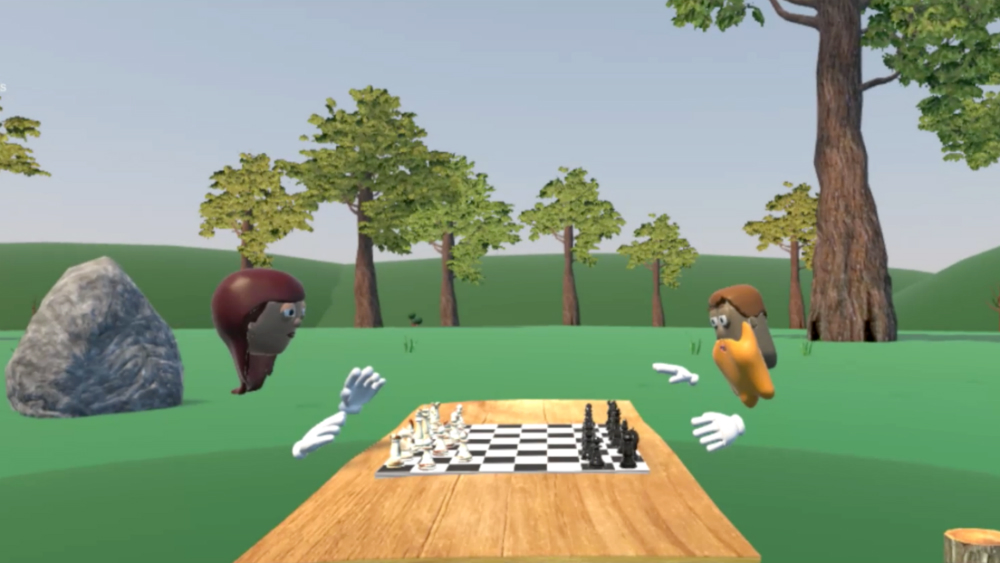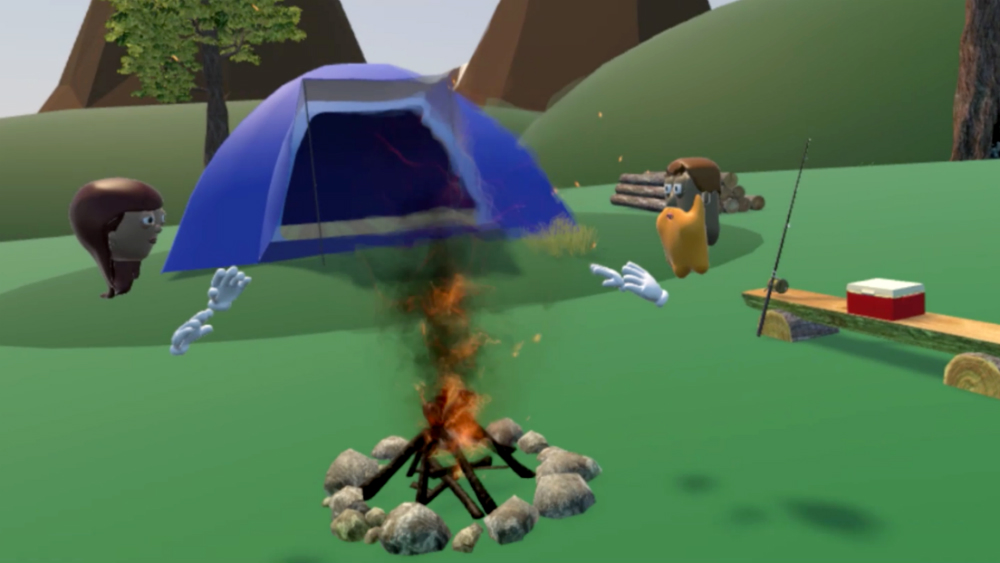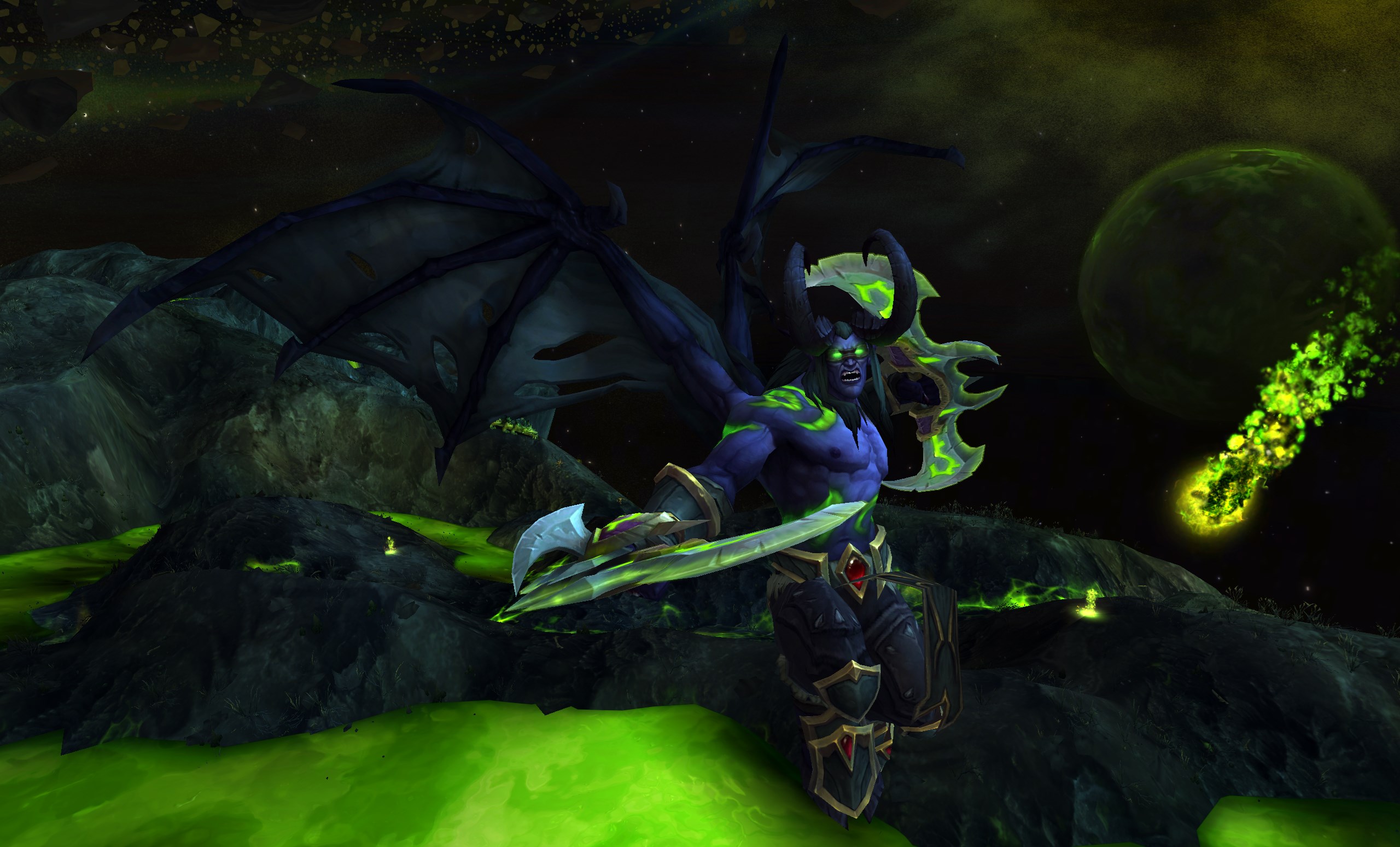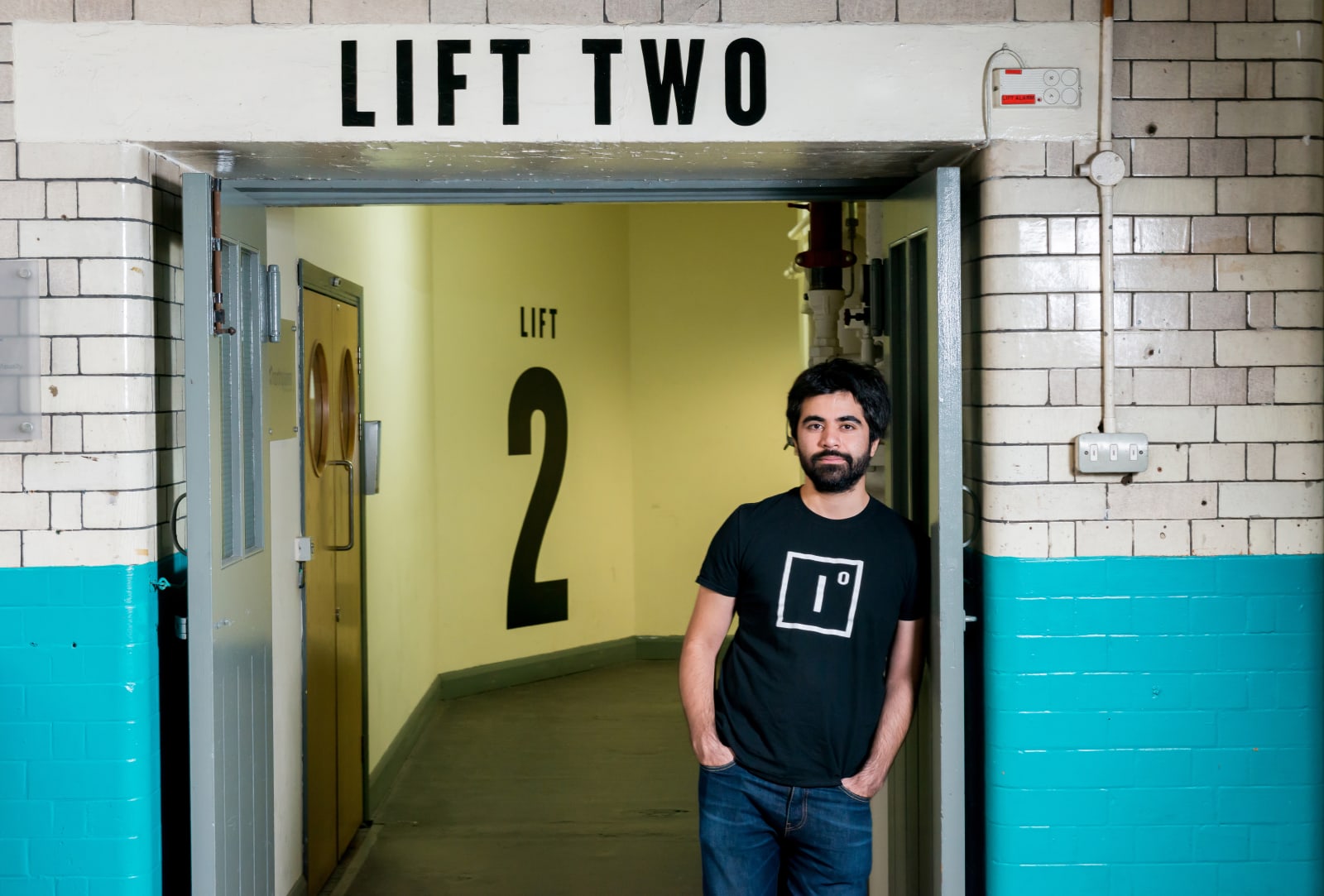Meeting strangers in the VR wilderness
I didn’t expect to see anyone. Not in the woods. I blink a few times and widen my stance, swiveling my head back and forth to see if there are others. No, just the one. A bearded face floating in midair, a pair of white gloves dangling underneath. “Was that…?” I whisper under my breath but before I can finish the question, the strange being has teleported a few meters toward me. Another split-second and he’s standing a stone’s throw away. “Hello,” he says with a wave and a grin.
The world I’m standing in doesn’t seem particularly dangerous. The sky is light blue, punctuated with sharp, angular mountains. Some birds are chirping in a nearby tree, and a basic campsite, complete with a tent and fire, is visible just behind me. Still, I’m tense. I was expecting a tranquil, solitary piece of escapism in VR — this stranger has caught me off guard. “Oh, hi,” I offer with a hint of trepidation. He’s not an NPC (non-player character), that’s for sure. The intonation in his voice, his body language — if you can call it body language — it’s too real. “Are you a member of the press? Or someone working on the game?” I probe, cautiously.
The bearded man, it turns out, is Dedric Reid, founder and CEO of Hello VR. His company built this virtual escape, called the “MetaWorld,” as a way for people to meet up and socialize. I’m jacking in from London, with an HTC Vive strapped to my face, while Reid is based in San Francisco. With some wand controllers and room-scale tracking, we can move our hands, pick up objects and walk around in a limited capacity.
Our impromptu meetup was, in fact, a cleverly orchestrated introduction to the game and its creator. I smile and shake my head as we exchange pleasantries, realizing how I was ever so subtly duped. There was little explanation when I entered this virtual world, and that was intentional: The developers wanted to show me what it’s like to meet a stranger in VR.
The MetaWorld feels vast but primitive. The ground is flat, a single shade of green stretching into the distance. I can see some trees, but they have simple textures and basic, circular shadows. Compared to a blockbuster video game like The Witcher 3, or even smaller titles such as Firewatch, it looks basic. But unlike those games, the MetaWorld is properly persistent. When you throw a rock or drop a stick, it stays in that exact spot until you or someone else decides to move it. The idea is that the space has its own ecology and history, changing over time as people interact with it.
“If I wasn’t conducting an interview, I think we would be bonding; remove the questions and we’re messing about, just killing time.”
The woods where we’re chatting measure a square mile. But this “place,” as the developer calls it, is only one thread in a tapestry that will eventually measure 80,000 square miles. Each will be molded by the community and allow for different types of activities. In this one, for instance, Hello VR wants to make a fishing mini-game and other camp-related tasks. Reid points to a table with a chessboard in the distance and explains how to teleport — the only way of moving beyond HTC’s room-scale body-tracking. By pressing the touchpad on the right controller, I can see a flight path and my projected position. Moving the wand changes the destination and tapping the trigger on the underside of the remote executes the jump.

The chess pieces are scattered across the board. As I pick up the rook and place it on the back row, I’m struck by the strangeness of the situation. I’m hanging out with Reid. It’s more than a conversation — that could be done on the telephone or over Skype. It’s the sense of presence and our physical interactions. If I weren’t conducting an interview, I think we would be bonding; remove the questions and we’re messing about, just killing time.
“We’re aiming for a very intimate experience,” Reid explains. “Something like this, we’ll limit to 20 or 30 people. Anything beyond that will break the level of social immersion that we’re trying to achieve. But beyond this space, we’re looking at thousands of players that could coexist.”
Work to be done
The MetaWorld has been in development for six months though Reid says he’s been working on the idea for well over a year. Before Hello VR, he contributed to the Xbox One as part of Microsoft’s Interactive Entertainment Business (IEB) and then, under Comcast, the Xfinity X1 cable box. In 2014, Reid became head of design for a company called AltspaceVR, which is developing a virtual playground similar to the MetaWorld, where people can hang out, play games and watch movies together. The big difference is that the world isn’t persistent or as large as the one that Reid wants to build with Hello VR.
Future versions of the MetaWorld will have full character models and a backpack for managing your inventory. As you wander through the woods, you’ll be able to pick up items and store them in a 3D-modeled rucksack. You’ll swing it over your shoulder and use your hands to dig inside, compare and share your belongings. It’s a novel approach to inventory management and one that promotes exploration, social interaction and ownership over what can otherwise feel like virtual tat in video games.
Hello VR has a lot of work to do. Reid is keen for the community to shape the design and personality of each world. That means designing content-creation tools — a notoriously difficult problem in video games, especially if it involves freeform sculpting. Before that, however, Hello VR needs to build more objects and richness into the environment. Reid also wants “a sort of locomotion mechanic” that can supplement the game’s teleportation. “This is one square mile out of about 80,000, so how do we get to the other 79,999?” I give a half-hearted shrug in response, before realizing my character doesn’t have any shoulders. I raise my hands instead, palm-side up — the universal body language for “I don’t know” — which garners a quick chuckle from Reid.

Hello VR started with the Vive, but it’s looking at other VR platforms too. Reid says the MetaWorld could theoretically support a variety of headsets, including the Oculus Rift and PlayStation VR. The mechanics will need to be modified — Sony’s headset, for instance, doesn’t have room-scale body tracking — but he’s confident the controls can be adapted. In the end, he promises you won’t be able to tell which hardware people are using.
Meeting the founder of Hello VR online was exhilarating. But these sorts of public interactions won’t be for everyone. In fact, I can see the MetaWorld appealing to smaller groups of people that already know each other. I love the idea of kicking back with some friends after work, sitting around a campfire and exchanging stories. Or taking a virtual road trip and spending a day, if not more, pitching tents and playing hide-and-seek. Sure, it wouldn’t be the same as a real camping trip — the great outdoors is exactly that, outdoors — but it could serve as a decent substitute. Especially if you want to connect with friends who are scattered all over the world.
“That’s exactly what we’re thinking,” Reid says. “Honing in on the more intimate experiences, but also opening them up in a vast sort of way. It’s intimate, but it’s still vast; we’re not cooped up in a room together.”
We spent our last few minutes together trying to hit a rock with a stick. I was the pitcher; Reid was the batter. The results were terrible and also hilarious; it’s clear the game’s basic controls were never designed for such sportsmanship. Still, it was a fitting way to cap off our little meeting. We were doing nothing in particular — just goofing around like children. But doing that in VR, with the knowledge that thousands of miles separate us, felt special. Eventually, we shook hands and said goodbye.
Improbable, not impossible
The MetaWorld is a grand undertaking. To build such a space would, years ago, have required an enormous budget and technical knowhow. Hello VR, however, claims to be sidestepping the problems by using Spatial OS, a service developed by a little-known company called Improbable.
The team, which numbers around 100, has developed a way to better harness servers and their computational power. You may have noticed that in most MMORPGs, like World of Warcraft, the player base is split into different servers. The world might be large, but it’s effectively mirrored for these groups. The monsters are tightly regulated, both in number and where they can roam. Environmental damage disappears. These restrictions help the developer to control the game experience, and, more importantly, manage the load on its servers. Allowing every monster and player to fight in the same dungeon would cause the game to crash.

World of Warcraft, the most popular MMORPG. Credit: Blizzard
There are ways to get around this. CCP Games, which runs the spaceflight MMO EVE Online, has a feature called “time dilation,” which slows down particularly large battles so that its servers can keep up. Improbable thinks it can solve this problem by chaining servers together into a swarm-like platform. The technology means that data and problem-solving can be shared between them, enabling larger worlds and more complex ecosystems. “It’s like a giant game of musical chairs,” Herman Narula, CEO of Improbable says, “where servers and computational agents are moving between different machines in order to make the simulation possible.”
It’s a deep engineering problem, and one that few companies have been able to solve before now. “It’s not like a footnote or a little library or background detail,” Narula explains. “It’s a whole new science. A new approach to making large-scale distributed systems possible.”

Herman Narula, CEO of Improbable. Credit: Edge Magazine via Getty Images
The company is offering its capabilities through Spatial OS. Narula calls it a “distributed operating system,” referring to its ability to run a single application on a thousand different machines. Developers can log onto the Improbable website and download a console application that allows them to program a game or experience compatible with Spatial OS’ APIs. The final product can then be “pushed” to servers that Improbable is renting from the usual technology behemoths, such as Amazon and Google.
The system means that Spatial OS customers pay Improbable, not the server-farm owners, for the computational power that they need. Improbable acts as the middle man for both parties, charging developers a subscription based on their usage and requirements.
Spatial OS can support many types of experiences: video games, such as the MetaWorld and the equally persistent Worlds Adrift, city simulations and medical research. The only requirement is that each project involves entities, with properties, in some kind of space. (Hence the name.) You wouldn’t use the platform to analyze language in a million books, for instance. That’s a problem that could be split up and handled by many servers working in isolation. Instead, Spatial OS is designed to deal with objects that interact and influence one another — animals in an MMORPG, or cars trying to weave their way through a traffic jam.
Keeping quiet
Improbable is working with a small group of developers right now. The company has been “deeply involved” with some of these early testers, but the plan is to build an interface that people can use entirely on their own. “The end game is that you rock up to the Spatial OS website, download the SDK and then you’re away,” Nurman says.
The company has been quiet for the last few years, beavering away at the algorithms that power Spatial OS. But slowly, it’s been expanding the pool of developers that have access to the platform. Worlds Adrift, a game developed by Bossa Studios, is one of the first projects to receive mainstream attention. And with good reason: It offers a large, persistent play space like the MetaWorld, which players can change and interact with in permanent, meaningful ways. “When a ship blows up, all of those little pieces fall to the ground, and they’re permanently there for thousands of other players to find,” Nurman says. “The ecology will then clean them up over time. All of this creates a whole new kind of experience.”
The promise of Spatial OS seems, at times, to be too good to be true. Maybe it is.
The promise of Spatial OS seems, at times, to be too good to be true. Maybe it is. But that’s why Improbable invited me in to see the MetaWorld and speak with Reid through VR. It’s a hint at the scale and social intimacy that can be achieved with a thousand servers working in harmony. “This is something tangible,” Nurman argues. “You put on a headset and you saw something today. That’s the beginning, the acorn of something interesting.”
(99)













